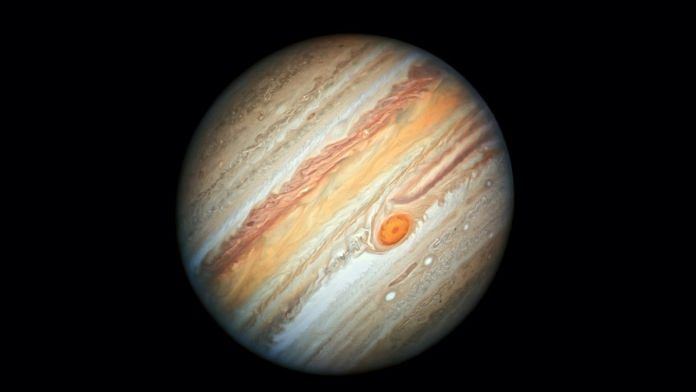New Delhi: In a first, scientists have solved Jupiter’s ‘energy crisis’ problem, which made it much hotter than usual despite the planet being five times further from the sun than Earth.
Based on the amount of sunlight received, the average temperature in the planet’s upper atmosphere should be about minus 73 degree Celsius. Instead, the measured value is as high as 426 degree Celsius. And for over 50 years, scientists have failed to determine the source of this extra heat.
However, scientists at NASA have now determined that Jupiter’s intense aurora, which is the most powerful in the solar system, is responsible for heating the planet’s upper atmosphere.
Auroras occur when electrically charged particles are caught in a planet’s magnetic field. These spiral along invisible lines of force in the magnetic field towards the planet’s magnetic poles, striking atoms and molecules in the atmosphere to release light and energy.
Read more on this here.
Scientists freeze dry mice sperm to allow transporting samples via postcard
Scientists in Japan have developed a way to freeze dry mouse sperm on a plastic sheet, which allows these samples to be mailed via postcards. With this, sperm samples can be transported easily, inexpensively and without the risk of glass cases breaking.
The effort to freeze-dry sperms was taken to undertake easy transportation of samples to space stations to study the the effects of space radiation on baby mice.
The sperm was originally preserved in a glass bottle. But these can break easily, and so have to be cushioned to prevent breakage during the rocket launch.
The Japanese scientists were able to mail the mouse sperm as postcards by attaching the plastic sheet to the postcard with no protection. One scientist even sent another a “Happy New Year” card with mouse sperm attached as a gift.
Read more here.
Earth’s rotation linked to origin of life
The shift of Earth from low oxygen levels to an oxygen rich planet is key to the origin of life but for decades the reason that explained this process eluded scientists.
A new study has found that as the spin of the young Earth gradually slowed over time, making days longer, the amount of oxygen released by photosynthetic cyanobacteria increased. This is because photosynthesis occurs in the presence of light.
The team from University of Michigan in the US studied present day microbial communities living at the bottom of a submerged Lake Huron sinkhole, which is 80 feet below the water’s surface.
The water in the Middle Island sinkhole is rich in sulfur and low in oxygen. Bacteria that thrive in these conditions are similar to single-celled organisms that lived billions of years ago, covering both land and seafloor surfaces.
The researchers showed that longer days increase the amount of oxygen released by photosynthetic microbial mats. This suggests that the Earth’s oxygenation history and its rotation rate is likely to be linked.
While the Earth now spins on its axis once every 24 hours, day length was possibly as brief as six hours during the planet’s early years.
Read more on this here.
Also read: 15,000-yr-old viruses found in China & the unique shark intestines that work like a Tesla valve
How the Stonehenge survived the test of time
Scientists may now have the answer to how the ancient stone monument Stonehenge in the UK has withstood the test of time.
While the Stonehenge, which is made up of 52 megaliths, dates back to 5,000 years ago, scientists had been unable to drill, cut or subject it to chemical analysis due to its protected status.
Now, using a core sample taken from one of the ancient pillars about 50 years ago, scientists have been able to shed some light on the composition of the monument.
Before the monument got its protected status, workers in 1958 who were hired to restore the monument drilled into one of the stones and extracted core samples. Parts of one of the cores were discovered in a museum in 2019, another was held as a souvenir by a worker who immigrated to the US while the third has never been found.
Three years ago, the souvenir sample was returned to England for research.
The team found that the stone was 99.7 percent quartz and that there were different grain sizes. Some medium sized grains form “an interlocking mosaic of crystals”.
This was as strong as cement, which explains how the stones that make up Stonehenge have managed to survive for so long.
Read more on this here.
Population in world’s flood-prone areas increasing
Populations in areas of the world that are prone to flooding have increased by almost 25 per cent over the last two decades. An additional 86 million people now live within flood-prone regions, according to a new study based on satellite data.
Floods are among the most common extreme weather events driven by climate change. Of late, frequent and heavy rainfall is making floods more frequent.
Researchers in the US used data from the Global Flood Database, which collects data on rainfall levels, the number of deaths and people displaced as a result of hundreds of floods.
The data indicated that up to 86 million people have moved into known flood prone areas between 2000-2015, which is a 24 per cent increase. The migration is mostly linked to people looking for better economic opportunities.
A total of 2.23 million square kilometres were flooded between 2000 and 2018, affecting up to 290 million people, the study further noted.
Computer modelling additionally showed that climate change and shifting demographics would mean an additional 25 countries — including India — face a high risk of flooding by 2030.
Read more here.
(Edited by Rachel John)
Also read: Scientists discover 1,600-yr-old mummy of a sheep, & seismometres can trace wandering elephants






